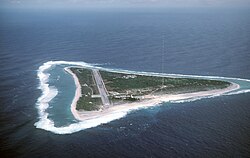
The extreme points of Japan include the coordinates that are the farthest north, south, east and west in Japan, and the ones that are at the highest and the lowest elevations in the country. Japan's northernmost point is disputed, because Japan considers it to be on Iturup, an island de facto governed by Russia. The southernmost point is Okinotorishima; the westernmost is Tuishi near Yonaguni Island in Okinawa Prefecture, and the easternmost is Minami Torishima. The highest point in Japan is the summit of Mount Fuji at 3,776.24 m (12,389 ft). At 150 m (492 ft) below sea level, the bottom of Hachinohe mine is the country's lowest point. The surface of Hachirōgata is Japan's lowest natural point at 4 m (13 ft) below sea level. All extreme locations are uninhabited.
Contents
Japan extends from 20° to 45° north latitude (Okinotorishima to Benten-jima) and from 122° to 153° east longitude (Yonaguni to Minami Torishima). [1] The coordinates used in this article are sourced from Google Earth, which makes use of the World Geodetic System (WGS) 84.







